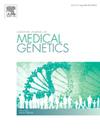rhoa相关疾病可以是非镶嵌性的。
IF 1.7
4区 医学
Q3 GENETICS & HEREDITY
引用次数: 0
摘要
在新发现的神经外胚层综合征、外胚层发育不良伴面部畸形、肢端、眼和脑异常、体细胞镶嵌中观察到RHOA的复发性体镶嵌致病变异[EDFAOB]。所有12例先前报道的患者都有RHOA变异的体细胞嵌合体。相反,没有患者与非花叶种系变异RHOA的报道。非花叶病患者的缺失被认为是所有RHOA变异在非花叶病状态下的致死效应。在这里,我们报告了一个11个月大的女性,具有edfaob样特征,但没有Blaschko皮肤病变或不对称。特征包括远端畸形、2-3趾皮肤并指、腭裂、子宫复制和肾脏畸形。她在外周血和口腔拭子的开关II区热点附近携带了非镶嵌新生种系变异RHOA:c.202C >a,p.(Arg68Ser)。一名患有RHOA非马赛克种系变异的活患者的记录否定了以前认为RHOA变异患者不能存活的观点。“非马赛克”rhoa相关疾病的鉴别诊断包括外胚层发育不良-指外裂综合征,因为这两种情况都有外胚层发育不良、手指异常和裂。这种表型相似性可以通过已知的TP63(负责EEC综合征的基因)与RHOA之间的分子相互作用来解释。RHOA是Rho小家族鸟苷三磷酸酶RAC亚家族的成员,包括RHOA、RAC1、RAC3和CDC42 (Takenouchi-Kosaki综合征)。本文中有关生殖系rhoa相关智力残疾的文献表明,Rho小家族gtpase的RAC亚家族的所有三个基因的变异与神经发育障碍有关。本文章由计算机程序翻译,如有差异,请以英文原文为准。
RHOA-associated disorder can be non-mosaic
Recurrent somatic mosaic pathogenic variants of RHOA have been observed in a newly identified neuroectodermal syndrome, Ectodermal Dysplasia with Facial Dysmorphism and Acral, Ocular, and Brain Anomalies, Somatic Mosaic [EDFAOB]. All 12 previously reported patients had somatic mosaicism for RHOA variants. Conversely, no patients with non-mosaic germline variants of RHOA have been reported. The absence of non-mosaic patients has been explained by the presumed lethal effect of all RHOA variants in non-mosaic status. Here we report an 11-month-old female with EDFAOB-like features but without Blaschko's skin lesions or asymmetry. Characteristic features included hypertelorism, 2–3 toes cutaneous syndactyly, cleft palate and duplicated uterus and kidney malformations. She carried the non-mosaic de novo germline variant RHOA:c.202C>A,p.(Arg68Ser) near the hotspot in the switch II region in peripheral blood and buccal swabs. The documentation of a living patient with a non-mosaic germline variant of RHOA negates the previous notion that patients with RHOA variants are not viable. The differential diagnosis of a “non-mosaic” RHOA-related disorder would include Ectodermal Dysplasia-Ectrodactyly-Clefting syndrome, as both conditions share ectodermal dysplasia, finger anomalies, and clefting. This phenotypic similarity may be explained by the known molecular interaction between TP63, the gene responsible for EEC syndrome, and RHOA. RHOA is a member of the RAC subfamily of small Rho family guanosine triphosphatases, which include RHOA, RAC1, RAC3, and CDC42 (Takenouchi-Kosaki syndrome). The documentation of germline RHOA-associated intellectual disability in the present article establishes that variants in all three genes of the RAC subfamily of small Rho family GTPases are associated with neurodevelopmental disorders.
求助全文
通过发布文献求助,成功后即可免费获取论文全文。
去求助
来源期刊
CiteScore
4.10
自引率
0.00%
发文量
193
审稿时长
66 days
期刊介绍:
The European Journal of Medical Genetics (EJMG) is a peer-reviewed journal that publishes articles in English on various aspects of human and medical genetics and of the genetics of experimental models.
Original clinical and experimental research articles, short clinical reports, review articles and letters to the editor are welcome on topics such as :
• Dysmorphology and syndrome delineation
• Molecular genetics and molecular cytogenetics of inherited disorders
• Clinical applications of genomics and nextgen sequencing technologies
• Syndromal cancer genetics
• Behavioral genetics
• Community genetics
• Fetal pathology and prenatal diagnosis
• Genetic counseling.

 求助内容:
求助内容: 应助结果提醒方式:
应助结果提醒方式:


